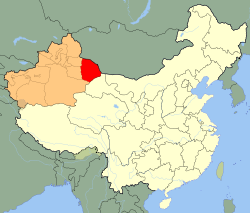- Kumul Khanate
-
Kumul Khanate
'Vassal of the Qing dynasty (1757-1912)
Vassal of the Republic of China(1912-1930)← 
1930  [[Republic of China|→]]
[[Republic of China|→]]Kumul Khanate Capital Kumul, Xinjiang Religion Sunni Islam Government Monarchy Khan Muhammad Shah - 1908-1930 Maqsud Shah (last) Chancellor/Vizier Unknown - 1930 Yulbars Khan (last) History - Established Enter start year - Disestablished 1930 The Kumul Khanate was a semi-autonomous feudal khanate within the Qing dynasty and then the Republic of China until it was abolished by Xinjiang governor Jin Shuren in 1930.
History
The khans of Kumul were direct descendants of the khans of the Chagatai Khanate. It came under Qing rule in 1757 after the Ten Great Campaigns and remained a Khanate as a part of the Qing empire.
Beiginning in 1647, the rulers of Hami submitted to the Qing dynasty and sent tribute. The title "Jasak Darhan", was granted to Abdullah Beg, ruler of Hami.[1][2][3]
The khanate had fought against the Zunghars for the Qing. Kumul continued as a vassal khanate when Xinjiang was changed into a province in 1884 after the Dungan revolt.[4]
The khans also were given the title of Qinwang (Prince of the First Rank Chinese: 親王; pinyin: qīn wáng), by the Qing empire. The khans were allowed enormous power by the Qing court, with the exception of administering execution, which had to be allowed by a Chinese official posted in Kumul.[5][6] The khans were officially vassals to the Emperor of China, and every six years were required to visit Beijing to be a servant to the Emperor during a period of 40 days.[7][8]
It was also known as the principality of Kumul, and the Chinese called it Hami.[9] The khans were friendly to Chinese rule and authorities.[10]
The Khan Muhammad and his son and successor Khan Maqsud Shah heavily taxed his subjects and extorted forced labor, which resulted in two rebellions against his rule in 1907 and 1912.[11]
The Kumul Khanate was the only part of Xinjiang which was not opened to settlement by Han Chinese. All other parts were subject to settlement encouraged by the government.[4]
The khan was assisted by a chancellor/vizer/chief minister in his court. The last khan, Maqsud Shah, had Yulbars Khan, the tiger Prince of Hami as his chancellor.[12]
The khan paid tribute to the Xinjiang government in Urumqi.[13]
The Han Chinese Governor of Xinjiang, Yang Zengxin was a monarchist, and tolerated the khanate, and was friendly toward the khan Maqsud Shah.
Around the 1920s Japanese secret agents began exploring the Kumul area.
It was the fact that the khanate existed which prevented the Uyghurs from rebelling, since the khanate represented a government where a man of their ethnicity and religion was reigning. The abolition of the khanate led to a bloody rebellion.[14]
Upon Maqsud Shah's death in 1930 Jin Shuren replaced the khanate with three normal provincial administrative districits Hami, Yihe, Yiwu. This set off the Kumul Rebellion, in which Yulbars Khan attempted to restore the heir Nasir to the throne.[15]
References
- ^ Library of Congress. Orientalia Division (1943). Arthur William Hummel. ed. Eminent Chinese of the Chʻing period (1644-1912) (reprint ed.). Chʻeng Wen Publishing. p. 263. http://books.google.com/books?id=Hs8LhXwRqPgC&q=Hami,+under+Mohammedan+chiefs,+had+begun+to+send+tribute+to+the+Ch'ing+Court+after+1647.++Fifty+years+later+beg+then+the+chief+of+the+Mohammedans+at+Hami,+had+been+given+the+title+of+Jasak+Darhan+for+surrendering+the+son+of&dq=Hami,+under+Mohammedan+chiefs,+had+begun+to+send+tribute+to+the+Ch'ing+Court+after+1647.++Fifty+years+later+beg+then+the+chief+of+the+Mohammedans+at+Hami,+had+been+given+the+title+of+Jasak+Darhan+for+surrendering+the+son+of&hl=en&ei=I5fRTeDGMerj0QHD6IDnDQ&sa=X&oi=book_result&ct=result&resnum=3&ved=0CDAQ6AEwAg. Retrieved 2011-5-08.
- ^ Arthur William Hummel (1972). Arthur William Hummel. ed. Eminent Chinese of the Ch'ing period (1644-1912). Che̓ng Wen Publishing House. p. 263. http://books.google.com/books?id=Qf5VAAAAYAAJ&q=Hami,+under+Mohammedan+chiefs,+had+begun+to+send+tribute+to+the+Ch'ing+Court+after+1647.++Fifty+years+later+beg+then+the+chief+of+the+Mohammedans+at+Hami,+had+been+given+the+title+of+Jasak+Darhan+for+surrendering+the+son+of&dq=Hami,+under+Mohammedan+chiefs,+had+begun+to+send+tribute+to+the+Ch'ing+Court+after+1647.++Fifty+years+later+beg+then+the+chief+of+the+Mohammedans+at+Hami,+had+been+given+the+title+of+Jasak+Darhan+for+surrendering+the+son+of&hl=en&ei=PZjRTbSgHci-0AHNsJzgDQ&sa=X&oi=book_result&ct=result&resnum=1&ved=0CCoQ6AEwAA. Retrieved 2011-5-08.
- ^ Arthur William Hummel (1991). Arthur William Hummel. ed. Eminent Chinese of the Ch'ing period: 1644-1912, Volumes 1. SMC publ.. p. 263. ISBN 9576380669. http://books.google.com/books?id=YqNHAQAAIAAJ&q=Hami,+under+Mohammedan+chiefs,+had+begun+to+send+tribute+to+the+Ch'ing+Court+after+1647.++Fifty+years+later+beg+then+the+chief+of+the+Mohammedans+at+Hami,+had+been+given+the+title+of+Jasak+Darhan+for+surrendering+the+son+of&dq=Hami,+under+Mohammedan+chiefs,+had+begun+to+send+tribute+to+the+Ch'ing+Court+after+1647.++Fifty+years+later+beg+then+the+chief+of+the+Mohammedans+at+Hami,+had+been+given+the+title+of+Jasak+Darhan+for+surrendering+the+son+of&hl=en&ei=gJjRTYKfL8Hb0QHL1eGPDg&sa=X&oi=book_result&ct=result&resnum=2&ved=0CC0Q6AEwAQ. Retrieved 2011-5-08.
- ^ a b James A. Millward (2007). Eurasian crossroads: a history of Xinjiang. Columbia University Press. p. 190. ISBN 0231139241. http://books.google.com/books?id=8FVsWq31MtMC&pg=PA190&dq=maqsud+shah&hl=en&ei=PUmpTKapGYK8lQeltoSODQ&sa=X&oi=book_result&ct=result&resnum=5&ved=0CDsQ6AEwBA#v=onepage&q=maqsud%20shah&f=false. Retrieved 2010-06-28.
- ^ Alexander Douglas Mitchell Carruthers, Jack Humphrey Miller (1914). Unknown Mongolia: a record of travel and exploration in north-west Mongolia and Dzungaria, Volume 2. Lippincott. p. 487. http://books.google.com/books?id=DHsTAAAAYAAJ&pg=PA487&dq=kumul+khanate&hl=en&ei=m0ipTMeuC4X7lweGkcWdBQ&sa=X&oi=book_result&ct=result&resnum=4&ved=0CDMQ6AEwAw#v=onepage&q=kumul%20khanate&f=false. Retrieved 2010-06-28.
- ^ Carruthers Douglas (2009). Unknown Mongoli: A Record of Travel and Exploration in North-West Mongolia and Dzungaria. BiblioBazaar, LLC. p. 487. ISBN 1110313845. http://books.google.com/books?id=nUt_g-c1Y5EC&pg=PA487&dq=kumul+khanate&hl=en&ei=m0ipTMeuC4X7lweGkcWdBQ&sa=X&oi=book_result&ct=result&resnum=5&ved=0CDkQ6AEwBA#v=onepage&q=kumul%20khanate&f=false. Retrieved 2010-06-28.
- ^ Alexander Douglas Mitchell Carruthers, Jack Humphrey Miller (1914). Unknown Mongolia: a record of travel and exploration in north-west Mongolia and Dzungaria, Volume 2. Lippincott. p. 489. http://books.google.com/books?id=DHsTAAAAYAAJ&pg=PA487&dq=kumul+khanate&hl=en&ei=m0ipTMeuC4X7lweGkcWdBQ&sa=X&oi=book_result&ct=result&resnum=4&ved=0CDMQ6AEwAw#v=onepage&q=mahsud%20shah%20vassal%20emperor%20pekin%20servant&f=false. Retrieved 2010-06-28.
- ^ Alexander Mildred Cable, Francesca French (1944). The Gobi desert. Hodder and Stoughton. p. 134. http://books.google.com/books?id=DzNyAAAAMAAJ&q=maksud+shah&dq=maksud+shah&hl=en&ei=iEmpTPilJ4LGlQeP8sy_DA&sa=X&oi=book_result&ct=result&resnum=6&ved=0CD4Q6AEwBQ. Retrieved 2010-06-28.
- ^ Reginald Charles Francis Schomberg (1933). Peaks and plains of central Asia. M. Hopkinson ltd.. p. 78. http://books.google.com/books?ei=m0ipTMeuC4X7lweGkcWdBQ&ct=result&id=pXlCAAAAIAAJ&dq=kumul+khanate&q=Our+destination+was+the+Khanate+or+principality+of+Kumul%2C+known+to+the+Chinese+as+Hami%2C+and+lying+far+to. Retrieved 2010-06-28.
- ^ Royal Central Asian Society, Central Asian Society, London (1934). Journal of the Royal Central Asian Society, Volume 21. Royal Central Asian Society.. p. 82. http://books.google.com/books?id=xhTMXTvVNjUC&q=kumul+khanate&dq=kumul+khanate&hl=en&ei=m0ipTMeuC4X7lweGkcWdBQ&sa=X&oi=book_result&ct=result&resnum=9&ved=0CE0Q6AEwCA. Retrieved 2010-06-28.
- ^ S. Frederick Starr (2004). Xinjiang: China's Muslim borderland. M.E. Sharpe. p. 74. ISBN 0765613182. http://books.google.com/books?id=GXj4a3gss8wC&pg=PA74&dq=maqsud+shah&hl=en&ei=PUmpTKapGYK8lQeltoSODQ&sa=X&oi=book_result&ct=result&resnum=2&ved=0CCwQ6AEwAQ#v=onepage&q=maqsud%20shah&f=false. Retrieved 2010-06-28.
- ^ Kate James (2006). Women of the Gobi: Journeys on the Silk Road. Pluto Press Australia. p. 178. ISBN 1864033290. http://books.google.com/books?id=h3FHwdHpdu4C&pg=PA187&dq=maksud+shah&hl=en&ei=iEmpTPilJ4LGlQeP8sy_DA&sa=X&oi=book_result&ct=result&resnum=4&ved=0CDQQ6AEwAw#v=onepage&q=maksud%20shah%20tiger%20prince&f=false. Retrieved 2010-06-28.
- ^ Andrew D. W. Forbes (1986). Warlords and Muslims in Chinese Central Asia: a political history of Republican Sinkiang 1911-1949. Cambridge, England: CUP Archive. p. 247. ISBN 0521255147. http://books.google.com/books?id=IAs9AAAAIAAJ&dq=kumul+khanate&q=maqsud+death+1908#v=snippet&q=maqsud%20death%201908&f=false. Retrieved 2010-06-28.
- ^ Andrew D. W. Forbes (1986). Warlords and Muslims in Chinese Central Asia: a political history of Republican Sinkiang 1911-1949. Cambridge, England: CUP Archive. p. 44. ISBN 0521255147. http://books.google.com/books?id=IAs9AAAAIAAJ&pg=PA44&dq=maqsud+shah&hl=en&ei=HziqTNyjJMWBlAfamoG_DA&sa=X&oi=book_result&ct=result&resnum=1&ved=0CCcQ6AEwAA#v=snippet&q=maqsud%20shah%20king%20gobi%20militia&f=false. Retrieved 2010-06-28.
- ^ James A. Millward (2007). Eurasian crossroads: a history of Xinjiang. Columbia University Press. p. 191. ISBN 0231139241. http://books.google.com/books?id=8FVsWq31MtMC&pg=PA190&dq=maqsud+shah&hl=en&ei=PUmpTKapGYK8lQeltoSODQ&sa=X&oi=book_result&ct=result&resnum=5&ved=0CDsQ6AEwBA#v=onepage&q=hami%20yihe%20yiwu&f=false. Retrieved 2010-06-28.
Categories:- Former monarchies of Asia
- Former countries in Asia
- States and territories disestablished in 1930
- History of Xinjiang
- Qing Dynasty
- Former kingdoms
- Uyghurs
- Historical Turkic states
- History of the Turkic people
- History of Central Asia
Wikimedia Foundation. 2010.

